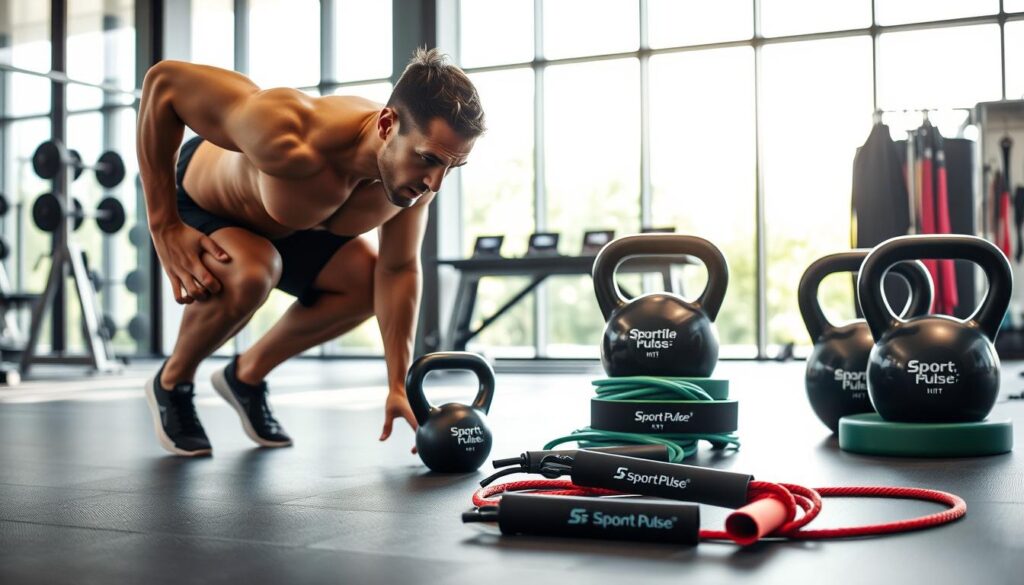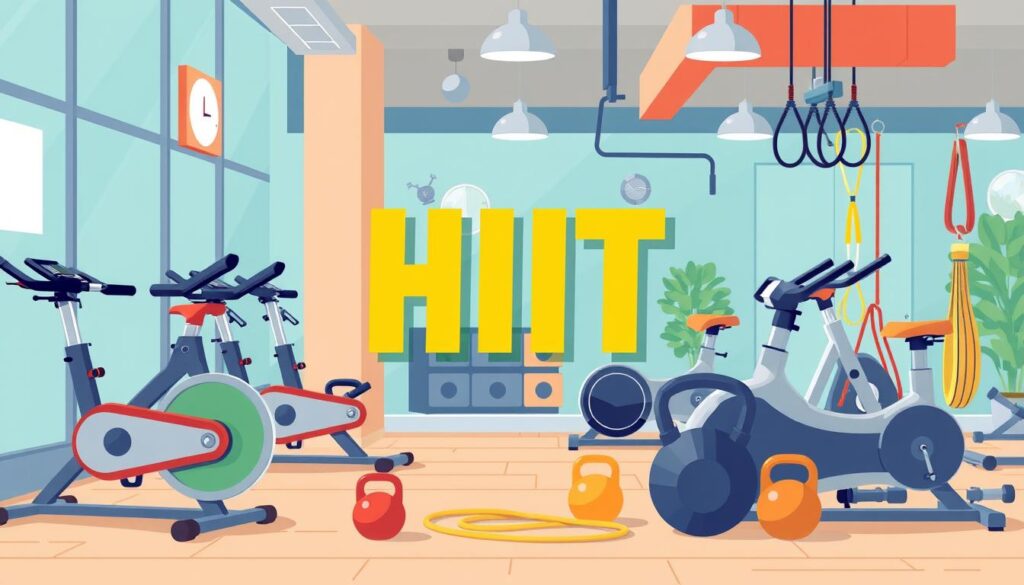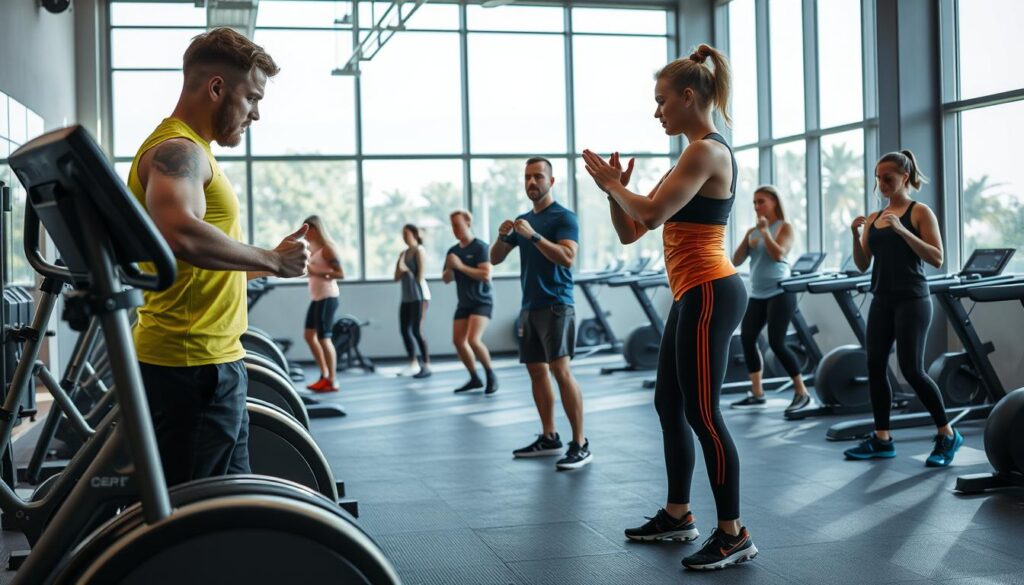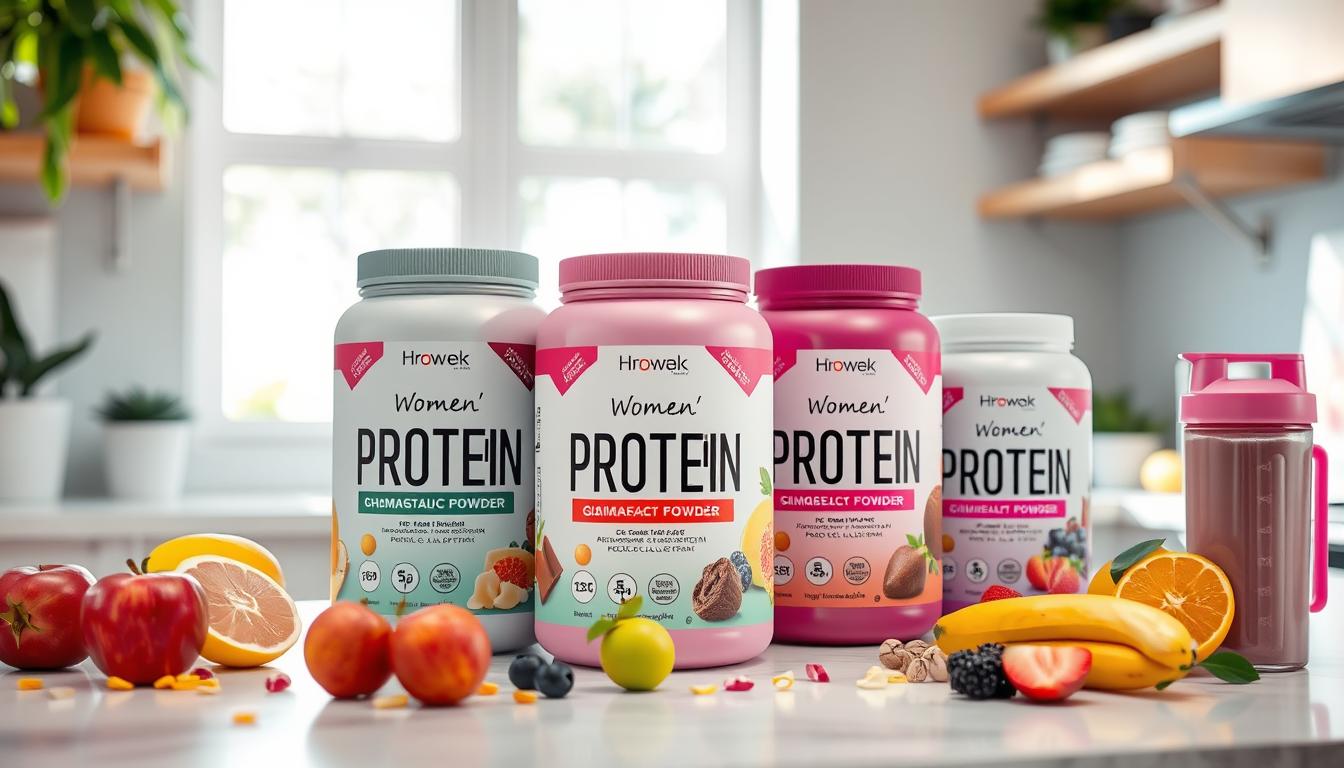Did you know that just 15-20 minutes of HIIT workout can be as effective as 45 minutes of traditional exercise? This surprising fact highlights the efficiency and potency of High-Intensity Interval Training, a method that’s revolutionizing the way we approach physical activity and fitness.
HIIT involves short bursts of intense exercise followed by brief periods of recovery, making it a time-effective way to improve health and fitness. By incorporating HIIT into your routine, you can achieve maximal benefits in minimal time, perfect for busy individuals looking to optimize their workout efficiency.
For those looking to enhance their training regimen, understanding the advantages of HIIT can be a game-changer. Whether you’re a fitness novice or an experienced athlete, HIIT’s intensity and interval structure can be tailored to suit your needs, helping you achieve your health goals faster.
Key Takeaways
- HIIT workouts offer maximum results in minimal time.
- Effective for burning calories and fat loss.
- Improves cardiovascular health and metabolic rate.
- Can be tailored for both beginners and seasoned athletes.
- Provides a time-efficient way to improve overall fitness.
Understanding High-Intensity Interval Training (HIIT)
The concept of HIIT revolves around short bursts of high-intensity exercise followed by brief periods of rest or low-intensity exercise. This training method has gained significant attention for its efficiency and effectiveness in improving cardiovascular health and burning calories.
What Defines HIIT Workouts
HIIT workouts are characterized by their unique structure, which involves alternating between periods of high-intensity exercise and recovery. For example, a HIIT workout using a stationary bike could consist of 30 seconds of cycling as fast as possible with high resistance, followed by several minutes of slow, easy cycling with low resistance. This cycle is typically repeated 4-6 times in a single workout session.
A key feature of HIIT is its ability to push the body to its limits during the intense exercise periods, resulting in a significant increase in heart rate and metabolic activity. The subsequent recovery periods allow the body to rest and prepare for the next bout of intense exercise.
How HIIT Differs from Traditional Exercise
HIIT differs from traditional steady-state cardio in several key ways. Firstly, HIIT involves alternating between very high intensity and recovery periods, whereas traditional cardio typically involves maintaining a moderate intensity for an extended period.
| Characteristics | HIIT | Traditional Exercise |
|---|---|---|
| Intensity | Alternates between high and low | Moderate intensity |
| Duration | Typically 10-30 minutes | Usually 45-60 minutes |
| Metabolic Impact | Significant afterburn effect (EPOC) | Limited afterburn effect |
| Adaptations | Both aerobic and anaerobic | Primarily aerobic |
Research has shown that HIIT can produce similar or greater improvements in cardiovascular fitness, insulin sensitivity, and fat loss compared to traditional exercise, all within a significantly shorter time commitment.
Why HIIT Has Become a Fitness Revolution
High-Intensity Interval Training (HIIT) has revolutionized the fitness world with its efficient and effective workouts. This training method has gained widespread popularity due to its ability to deliver significant health benefits in a short amount of time.
The Science Behind HIIT’s Popularity
The science behind HIIT’s popularity lies in its unique approach to physical activity. By incorporating short bursts of high-intensity exercise followed by brief periods of rest, HIIT maximizes calorie burn and improves cardiovascular health. This methodology not only enhances fitness levels but also boosts metabolism, leading to increased energy expenditure both during and after workouts.
Research has shown that HIIT can be an effective tool for improving various health markers, including insulin sensitivity and cardiovascular function. The adaptability of HIIT protocols allows individuals to tailor their workouts according to their fitness levels and goals.
Who Can Benefit from HIIT Training
HIIT can benefit a wide range of individuals, from people looking to improve their overall health to athletes seeking to enhance their performance. The benefits of HIIT include:
- Improved cardiovascular health and increased aerobic capacity
- Enhanced calorie burn and weight loss
- Increased muscle strength and endurance
- Better insulin sensitivity and glucose regulation
- Improved mental health and reduced stress levels
By incorporating HIIT into their training regimen, individuals can experience significant improvements in their overall fitness and health. As the body adapts to the demands of HIIT, individuals can expect to see enhancements in their physical performance and overall well-being.
Time Efficiency: Maximum Results in Minimal Time
The time efficiency of HIIT workouts is one of their most appealing benefits, allowing individuals to achieve more in less time. This is particularly valuable in today’s fast-paced world where finding time for exercise can be challenging.
Comparing HIIT Duration to Traditional Workouts
HIIT significantly reduces the time required for a effective workout compared to traditional exercise methods. While traditional workouts can last anywhere from 45 minutes to over an hour, HIIT sessions can be as short as 10-20 minutes.
| Workout Type | Duration | Frequency |
|---|---|---|
| Traditional Workout | 45-60 minutes | 4-5 times a week |
| HIIT Workout | 10-30 minutes | 2-3 times a week |
This comparison highlights the time-saving aspect of HIIT, making it an attractive option for those with busy schedules.
How HIIT Fits into Busy Schedules
The flexibility of HIIT allows it to be adapted to fit various schedules. Whether it’s a quick 4-minute Tabata session or a more comprehensive 30-minute workout, HIIT can be tailored to fit available time slots.
For people with unpredictable schedules, HIIT offers the flexibility to adjust workout length while maintaining effectiveness. This adaptability is a significant advantage over traditional cardio exercises, which often require longer minimum durations.
By incorporating HIIT into their routine, individuals can maintain consistent exercise habits with fewer weekly sessions, making it an ideal choice for busy professionals, parents, and students.
Calorie Burning Power of HIIT Workouts
The calorie-burning power of HIIT workouts is one of the key reasons for their growing popularity. This section will delve into how HIIT achieves this feat and the science behind its energy expenditure.
How HIIT Burns More Calories Than Other Exercises
HIIT stands out for its efficiency in burning calories compared to traditional exercise methods. During HIIT, the body is subjected to short bursts of vigorous exercise that significantly elevate the heart rate. This intense physical activity requires a lot of energy, leading to a higher caloric expenditure.
The unique aspect of HIIT is its ability to create an “oxygen debt” during high-intensity intervals. This debt is repaid during the recovery periods, resulting in increased overall oxygen consumption and energy expenditure. As a result, the body continues to burn calories at an elevated rate even after the workout is completed.
- The body rapidly depletes its phosphocreatine and glycogen stores during high-intensity intervals, requiring significant energy to replenish these substrates.
- The alternating intensity of HIIT increases cardiac output and the body’s immediate energy demands.
The Science of Energy Expenditure During HIIT
The science behind HIIT’s calorie-burning power lies in its impact on the body’s energy systems. When engaging in HIIT, the body’s energy demands skyrocket due to the high intensity of the workout. This leads to an increase in the release of catecholamines (adrenaline and noradrenaline), which further boosts energy expenditure through various metabolic pathways.
Research has shown that HIIT promotes greater mitochondrial adaptations than steady-state exercise. This enhances the cells’ ability to produce energy and increases the basal metabolic rate over time. The high neuromuscular demands of HIIT also require greater energy expenditure as multiple muscle groups are recruited at high intensities.

The Afterburn Effect: Elevated Metabolism Post-Workout
The afterburn effect, a phenomenon associated with HIIT, significantly elevates your metabolic rate for hours following exercise. This prolonged increase in metabolism is scientifically referred to as Excess Post-Exercise Oxygen Consumption (EPOC).
Understanding EPOC
EPOC represents the amount of oxygen required by the body to restore itself to a resting state after intense exercise. Several studies have demonstrated HIIT’s impressive ability to increase your metabolic rate for hours after exercise. Some researchers have even found that HIIT increases your metabolism after exercise more so than jogging or weight training.
The factors influencing EPOC include the intensity of the workout, individual fitness level, workout duration, and the specific HIIT protocol used. Higher-intensity HIIT protocols generally produce longer-lasting metabolic effects.
How Long the Metabolic Boost Lasts
Research shows that the metabolic boost from HIIT can last significantly longer than that from traditional exercise, with effects measurable for up to 24-48 hours post-workout in some studies. The most significant metabolic elevation typically occurs in the first 2-3 hours post-HIIT.
A comparative analysis of different exercise types and their impact on post-exercise metabolism is presented in the table below:
| Exercise Type | Duration of Metabolic Boost | EPOC Level |
|---|---|---|
| HIIT | Up to 48 hours | High |
| Steady-State Cardio | Up to 12 hours | Moderate |
| Weight Training | Up to 24 hours | Moderate to High |
As noted by a fitness expert, “The beauty of HIIT lies in its ability to not only burn calories during the workout but to continue burning them at an elevated rate long after the session is over.”
“The afterburn effect is a game-changer for those looking to maximize their metabolic rate and enhance fat loss.”
The metabolic boost from HIIT is not just about increased calorie burning but also includes enhanced fat oxidation. Regular HIIT training can lead to long-term increases in resting metabolic rate due to increases in lean muscle mass and mitochondrial density, creating a compounding effect on metabolism over time.
Fat Loss Benefits of HIIT Training
High-Intensity Interval Training (HIIT) has revolutionized the way we approach fat loss, offering a highly effective method for shedding unwanted pounds. This training method has gained popularity due to its efficiency and the significant results it delivers.
How HIIT Targets Stubborn Body Fat
HIIT is particularly adept at targeting stubborn body fat. Studies have shown that this form of exercise can lead to significant reductions in body fat. The intense bursts of activity characteristic of HIIT stimulate various physiological responses that enhance fat burning.
A key study found that after just 12 weeks of intense HIIT training, participants experienced a 19.5% reduction in abdominal visceral fat. This is significant because visceral fat is associated with various health risks, including cardiovascular disease and diabetes.
| Duration of HIIT Training | Reduction in Visceral Fat |
|---|---|
| 12 weeks | 19.5% |
| 10 weeks | Significant reduction observed |
HIIT’s Effect on Waist Circumference
One of the most noticeable effects of HIIT is its impact on waist circumference. Research indicates that regular HIIT can lead to a significant reduction in waist size. For instance, a study found that after 10 weeks of HIIT, participants had a reduction of 3 cm in their waist circumference.
Moreover, people with heart conditions experienced a 7.4% reduction in waist circumference after 33 sessions of HIIT. This demonstrates that HIIT can be beneficial for a wide range of individuals, including those with pre-existing health conditions.

- HIIT significantly reduces waist circumference, with average reductions of 3-4 centimeters after 10-12 weeks.
- It’s particularly effective at targeting abdominal fat, improving waist-to-hip ratios and metabolic health.
Muscle Building Potential with HIIT
HIIT workouts are not just about boosting cardiovascular fitness; they also offer substantial benefits for muscle development. While traditionally associated with cardio, the high-intensity nature of HIIT stimulates muscle growth and strength.
Research has shown that incorporating HIIT into a fitness routine can lead to significant gains in muscle strength and endurance. For instance, an increase of 0.8 kg in skeletal muscle mass was observed in seniors who performed HIIT workouts for 12 weeks. Moreover, six weeks of HIIT can increase peak power output by an average of 8% compared to continuous training.
Can HIIT Replace Weight Training?
While HIIT is effective for improving muscle strength and endurance, the question remains whether it can entirely replace traditional weight training. Studies have shown that HIIT can significantly improve muscle strength, with upper body strength increasing by 67.8% after 8 weeks of high-intensity interval workouts. However, a well-rounded fitness routine may benefit from a combination of both HIIT and weight training to maximize muscle development and overall fitness.
For those looking to build muscle, incorporating exercises that target multiple muscle groups at once is crucial. HIIT workouts often involve such exercises, making them effective for muscle building. Nonetheless, weight training allows for more isolated muscle group targeting, which can be beneficial for comprehensive muscle development.
Which Muscle Groups Benefit Most from HIIT
Various muscle groups benefit from HIIT, with the lower body, core, and upper body all seeing improvements. The lower body muscle groups, including quadriceps, hamstrings, glutes, and calves, are heavily engaged during common HIIT exercises like sprinting, jumping, and cycling.
Core muscles, including abdominals, obliques, and lower back, are also significantly engaged, especially during full-body HIIT movements. This leads to improved core strength and endurance. Upper body muscles can also benefit when appropriate exercises are included in the HIIT routine.
| Muscle Group | Typical HIIT Exercises | Benefit |
|---|---|---|
| Lower Body | Sprinting, Jumping, Cycling | Increased Strength and Endurance |
| Core | Full-body movements, Burpees | Improved Core Strength and Endurance |
| Upper Body | Push-ups, Pull-ups, Dumbbell exercises | Enhanced Muscle Strength |
Studies have demonstrated that leg muscle strength can increase by approximately 7.6% after 8 weeks of HIIT performed 3 times weekly. Additionally, multimodal HIIT that combines strength exercises with high-intensity intervals has been shown to increase squat endurance by 280%, broad jump distance by 6%, deadlift by 18%, and leg press strength by 27%.
In conclusion, HIIT offers significant muscle-building potential, making it a valuable addition to any fitness routine aimed at improving muscle strength and endurance.
Top Benefits of High-Intensity Interval Training (HIIT) for Cardiovascular Health
HIIT has been shown to have a significant positive impact on cardiovascular health, offering a range of benefits that make it a valuable addition to any fitness routine. The advantages of HIIT for heart health are supported by a growing body of research.
HIIT’s Impact on Heart Rate and Recovery
One of the key benefits of HIIT is its effect on heart rate and recovery. Studies have shown that regular HIIT exercise can lead to improvements in heart rate variability and faster recovery times after exercise. This is particularly important for overall heart health, as it indicates a more resilient cardiovascular system.

Blood Pressure Improvements from HIIT
HIIT has also been shown to have a positive impact on blood pressure. Research indicates that HIIT can reduce blood pressure in individuals with hypertension, with some studies suggesting that it may be more effective than traditional continuous exercise. A study found that 8 weeks of HIIT on a stationary bike decreased blood pressure as much as traditional endurance training in adults with high blood pressure.
The benefits of HIIT for blood pressure are thought to be due to several mechanisms, including improved nitric oxide production, which promotes vasodilation and enhances blood vessel function. Additionally, HIIT’s ability to reduce arterial stiffness contributes to its blood pressure-lowering effects.
| Study | Duration | Effect on Blood Pressure |
|---|---|---|
| HIIT on stationary bike | 8 weeks | Decreased blood pressure comparable to traditional endurance training |
| HIIT vs. moderate-intensity exercise | Variable | HIIT may reduce blood pressure more than moderate-intensity exercise |
| HIIT in adults with hypertension | 22 sessions | Reduced systolic blood pressure by up to 23% |
Overall, the evidence suggests that HIIT is a valuable training method for improving cardiovascular health, particularly in terms of its effects on heart rate, recovery, and blood pressure.
Oxygen Consumption and Respiratory Benefits
The benefits of HIIT extend far beyond cardiovascular improvements, significantly impacting oxygen consumption and respiratory efficiency. By pushing the body to its limits through short bursts of intense exercise, HIIT stimulates significant adaptations in how the body utilizes oxygen and manages respiratory functions.
How HIIT Improves VO2 Max
One of the key respiratory benefits of HIIT is its ability to improve VO2 max, a measure of the body’s ability to use oxygen during intense exercise. Studies have shown that HIIT training can lead to significant improvements in VO2 peak levels. For instance, overweight and obese women who performed HIIT four times a week for just 5 weeks experienced a 9.1% increase in their VO2 peak levels. Similarly, seniors who engaged in HIIT for 28 weeks saw a 26% improvement in their oxygen usage. These improvements are attributed to the intense nature of HIIT workouts, which challenge the body’s aerobic capacity and lead to enhanced oxygen utilization.
- Rapid improvements in VO2 max can be achieved through consistent HIIT, with noticeable changes in as little as 5 weeks.
- The adaptability of HIIT to different populations, including seniors and those who are overweight or obese, makes it a versatile training method.
- Improvements in VO2 max are indicative of better cardiovascular and respiratory health, enhancing overall exercise performance.
Respiratory Efficiency Gains
HIIT not only improves oxygen consumption but also enhances respiratory efficiency. The high ventilatory demands during HIIT intervals train the respiratory system to become more efficient at oxygen intake and carbon dioxide removal. After just 12 weeks of HIIT, individuals can experience up to a 43% increase in respiratory muscle function. This improvement is crucial for overall respiratory health, as it allows for more efficient gas exchange and reduced breathlessness during daily activities.
Furthermore, HIIT has been shown to improve ventilatory efficiency and increase lung capacity, benefiting individuals with respiratory conditions such as asthma or COPD. The enhanced respiratory efficiency translates to improved exercise tolerance and a better quality of life, particularly for those with existing respiratory limitations.
Blood Sugar Regulation and Insulin Sensitivity
High-Intensity Interval Training (HIIT) has emerged as a powerful tool in managing blood sugar levels and enhancing insulin sensitivity. This form of exercise has been shown to have a significant impact on how the body regulates blood sugar and responds to insulin.
Research indicates that HIIT can significantly improve insulin sensitivity, meaning it enhances the body’s ability to use insulin and absorb sugar. This improvement is crucial for maintaining healthy blood sugar levels and preventing conditions like type 2 diabetes.
HIIT for Diabetes Prevention and Management
HIIT has been found to be particularly beneficial for individuals at risk of or living with type 2 diabetes. By improving insulin sensitivity, HIIT helps the body to more effectively manage blood glucose levels. Studies have shown that HIIT can improve insulin sensitivity by 23-58% after just 8-16 weeks, outperforming traditional continuous exercise in some cases.
- HIIT directly targets insulin resistance by enhancing the muscles’ ability to take up glucose from the bloodstream.
- The high-intensity nature of HIIT activates a greater percentage of muscle fibers, creating widespread improvements in cellular insulin sensitivity.

How HIIT Affects Insulin Resistance
HIIT affects insulin resistance by increasing GLUT4 translocation to muscle cell membranes, enhancing the muscles’ ability to uptake glucose without requiring as much insulin. The metabolic stress of HIIT also stimulates mitochondrial biogenesis, improving the cells’ ability to metabolize glucose and reducing insulin resistance at a cellular level.
Furthermore, HIIT reduces inflammatory markers associated with insulin resistance and improves the insulin receptor β subunit in skeletal muscle. These changes contribute to improved insulin sensitivity and better blood sugar regulation.
The benefits of HIIT on insulin sensitivity can last for 24-72 hours after a single session, providing ongoing metabolic benefits even on non-exercise days. This prolonged effect makes HIIT a valuable component of a comprehensive exercise program aimed at improving insulin sensitivity and overall metabolic health.
Performance Enhancement Through HIIT
The incorporation of HIIT into a training program can lead to remarkable improvements in both aerobic and anaerobic performance. This versatile training method has been shown to benefit athletes across various disciplines, from endurance sports to high-intensity activities.
Aerobic Performance Benefits
HIIT significantly enhances aerobic performance by improving cardiovascular function and increasing the body’s ability to utilize oxygen. Studies have demonstrated that HIIT can lead to improvements in VO2 max, a key indicator of aerobic fitness. This improvement allows athletes to perform at higher intensities for longer durations. As a result, HIIT is an effective training method for endurance athletes looking to boost their performance.
Anaerobic Performance Improvements
HIIT directly enhances anaerobic performance by improving the body’s ability to buffer lactic acid, allowing athletes to sustain high-intensity efforts for longer before fatigue sets in. Research shows that HIIT can increase peak power output by an average of 8% after just six weeks, significantly improving explosive performance in sprinting, jumping, and other power activities. Additionally, HIIT stimulates the production of human growth hormone (HGH) by up to 450% for several hours post-exercise, contributing to improved recovery and anaerobic capacity over time.
Other key benefits of HIIT for anaerobic performance include enhanced phosphocreatine recovery, improved neuromuscular coordination, and increased anaerobic threshold. As noted by a study, “The combination of improved ATP-PC system function, glycolytic capacity, and neuromuscular efficiency from HIIT creates comprehensive improvements in all aspects of anaerobic performance.” This makes HIIT an invaluable training tool for athletes requiring quick bursts of energy.
Creating Your Own HIIT Workout Routine

To get the most out of HIIT, it’s essential to craft a routine that suits your fitness level. A well-designed HIIT workout can help you achieve your fitness goals efficiently.
Choosing the Right HIIT Activities
Selecting the appropriate exercise for your HIIT training is crucial. You can choose from a variety of exercise options, including sprinting, cycling, or bodyweight exercises. The key is to pick activities that you enjoy and that challenge you.
When selecting HIIT activities, consider your fitness goals and current fitness level. For beginners, it’s advisable to start with lower impact activities and gradually move to more intense ones.
Structuring Work-to-Rest Ratios
The work-to-rest ratio is a critical component of HIIT program design. Beginners typically start with a 1:2 or 1:3 ratio (e.g., 20 seconds of work followed by 40-60 seconds of rest). As your fitness improves, you can adjust the ratio to 1:1 or even 2:1 for a greater challenge.
It’s also important to keep work periods under 30 seconds to maintain the required intensity. Adequate recovery between training sessions is essential to avoid injuries and ensure progressive overload.
Some popular HIIT protocols include the Tabata protocol (20 seconds work, 10 seconds rest, repeated 8 times) and the 4×4 protocol (4 minutes of high-intensity work followed by 3 minutes of active recovery, repeated 4 times). The optimal work-to-rest ratio varies based on individual fitness level, specific goals, and the particular HIIT activity chosen.
HIIT Equipment Options for Home and Gym

HIIT workouts are versatile and can be performed with or without equipment, but certain tools can significantly enhance the experience. Whether you’re training at home or in a gym, having the right equipment can add variety and intensity to your HIIT sessions.
No-Equipment HIIT Workouts
One of the benefits of HIIT is that it can be done without any equipment. Bodyweight exercises like burpees, squat jumps, and mountain climbers are effective for raising your heart rate and improving cardiovascular health. These exercises can be done anywhere, making HIIT a convenient training option for those with busy schedules.
Essential HIIT Training Gear
While HIIT can be done without equipment, certain tools can enhance your workout. A quality interval timer or smartphone app is essential for precise timing of work and rest periods. Cardio equipment like stationary bikes, rowing machines, and treadmills provide excellent platforms for HIIT, allowing for precise control of intensity.
Kettlebells, jump ropes, dumbbells, resistance bands, and medicine balls are also valuable for HIIT. They enable a variety of exercises that can elevate your heart rate and build strength simultaneously. Additionally, heart rate monitors can help ensure you’re maintaining the appropriate intensity during your workouts.
HIIT Safety Considerations and Precautions
Before diving into HIIT, it’s vital to be aware of the potential risks and take necessary safety measures. While HIIT is an effective way to improve fitness, its high-intensity nature can be demanding on the body.
Who Should Approach HIIT with Caution
Certain individuals should approach HIIT with caution due to its intense nature. This includes people with pre-existing health conditions, such as heart problems or severe joint issues. It’s essential to consult with a healthcare professional before starting any new exercise program, especially one as demanding as HIIT. They can help determine if HIIT is suitable for your fitness level and health status.
- Individuals with certain medical conditions should consult their doctor before starting HIIT.
- Those who are new to exercise or have been inactive for a long time should begin with lower intensity workouts.
- Pregnant women or those who have recently given birth should seek medical clearance before engaging in HIIT.
Preventing Injuries During High-Intensity Training
To minimize the risk of injury during HIIT, proper preparation and technique are crucial. Adequate warm-up and cool-down routines are essential to prepare the body for the intense workout and aid in recovery.
- Start with just 1-2 HIIT sessions per week and gradually increase frequency as your body adapts.
- Focus on proper form and technique rather than maximum speed to reduce the risk of injury.
- Choose exercises that are appropriate for your fitness level and any physical limitations you may have.

By being mindful of these safety considerations and taking the necessary precautions, you can enjoy the benefits of HIIT while minimizing its risks.
Incorporating HIIT into Your Existing Fitness Routine
Successfully incorporating HIIT into your existing workout schedule requires a balanced approach to exercise and recovery. To maximize the benefits of HIIT, it’s crucial to understand how to integrate it effectively with other forms of training and ensure adequate recovery time.
Balancing HIIT with Other Exercise Types
When adding HIIT to your exercise routine, it’s essential to strike a balance between high-intensity sessions and other forms of training. This balance ensures that you’re not overtraining while still challenging yourself. For instance, you can combine HIIT with moderate-intensity strength training and steady-state cardio to create a well-rounded workout schedule.
- Include 2-3 HIIT sessions per week, focusing on different modalities to avoid overuse.
- Pair HIIT with strength training on alternate days to allow for recovery.
- Incorporate active recovery days, such as light yoga or walking, to promote blood flow without adding training stress.
Sample Weekly Workout Schedule with HIIT
Here’s an example of how to incorporate HIIT into your workout schedule:
- Monday: 20-minute HIIT session focusing on full-body movements.
- Tuesday: Moderate-intensity strength training for upper body and core.
- Wednesday: Active recovery day with light activity.
- Thursday: 15-20 minute HIIT session using a different modality.
- Friday: Moderate-intensity strength training for lower body and core.
- Saturday: Longer, steady-state cardio session at moderate intensity.
- Sunday: Complete rest day or very light activity.
This balanced approach provides sufficient stimulus through two weekly HIIT sessions while allowing adequate recovery and addressing other fitness components. For a personalized workout schedule tailored to your specific goals and preferences, contact us via WhatsApp at +44-7822010953 for expert programming guidance.
Conclusion: Maximizing Your Fitness Journey with HIIT
High-Intensity Interval Training (HIIT) has emerged as a revolutionary fitness approach, offering numerous benefits in a time-efficient manner. This training method has gained popularity due to its ability to deliver significant results in less time compared to traditional exercise routines.
As discussed, HIIT involves short bursts of high-intensity exercise followed by brief periods of rest. This pattern not only boosts metabolism but also enhances cardiovascular health and improves insulin sensitivity. The versatility of HIIT allows it to be adapted to various fitness levels, making it accessible to a wide range of people.
The comprehensive benefits of HIIT include improved cardiovascular health, enhanced metabolism, better body composition, and increased performance. By incorporating HIIT into a balanced fitness routine that includes strength training, flexibility exercise, and adequate recovery, individuals can maximize their results.
To get started with HIIT, it’s essential to find the right balance of intensity, frequency, and exercise selection. This balance ensures that you challenge yourself appropriately without risking burnout or injury. As HIIT continues to be validated by research for its effectiveness in various health outcomes, it has become an evidence-based approach recommended by fitness professionals worldwide.
For personalized guidance on incorporating HIIT into your workout routine, reach out via WhatsApp Communication at +44-7822010953 to discuss how this effective training method can transform your fitness results.
## FAQ
### Q: What is the ideal duration for a HIIT workout session?
A: A typical HIIT workout session can last anywhere from 15 to 30 minutes, including warm-up and cool-down periods. The actual high-intensity exercise duration is usually much shorter, ranging from 4 to 20 minutes.
### Q: How often should I do HIIT workouts per week?
A: For most adults, 2-3 HIIT sessions per week are sufficient to see significant improvements in cardiovascular health, insulin sensitivity, and fat loss. However, this frequency can vary based on individual fitness goals and current fitness level.
### Q: Can HIIT workouts be done without any equipment?
A: Yes, many HIIT workouts can be done without any equipment. Bodyweight exercises like burpees, jump squats, and mountain climbers are effective for HIIT. You can also use stairs or running as part of a HIIT routine.
### Q: Is HIIT suitable for people with health conditions?
A: While HIIT can be beneficial for many, individuals with certain health conditions, such as heart disease or severe obesity, should consult with a healthcare provider before starting a HIIT program. Modifications can often be made to accommodate different fitness levels and health conditions.
### Q: How does HIIT affect muscle mass?
A: HIIT can help improve muscle endurance and, in some cases, contribute to muscle hypertrophy, especially when combined with resistance training exercises. However, for significant muscle gain, traditional resistance training may be more effective.
### Q: Can HIIT improve insulin sensitivity?
A: Yes, regular HIIT workouts have been shown to improve insulin sensitivity, which can be beneficial for preventing and managing type 2 diabetes. This improvement is partly due to the increased glucose uptake in muscles during and after exercise.
### Q: How long does it take to see results from HIIT workouts?
A: Many people start to notice improvements in cardiovascular fitness and fat loss within 6-8 weeks of regular HIIT workouts. However, individual results can vary based on factors like diet, consistency of workouts, and starting fitness level.
### Q: Is it normal to feel sore after HIIT workouts?
A: Yes, it’s common to experience muscle soreness, known as delayed onset muscle soreness (DOMS), after HIIT, especially if you’re new to this type of exercise or have increased the intensity. This soreness typically subsides within a few days.


